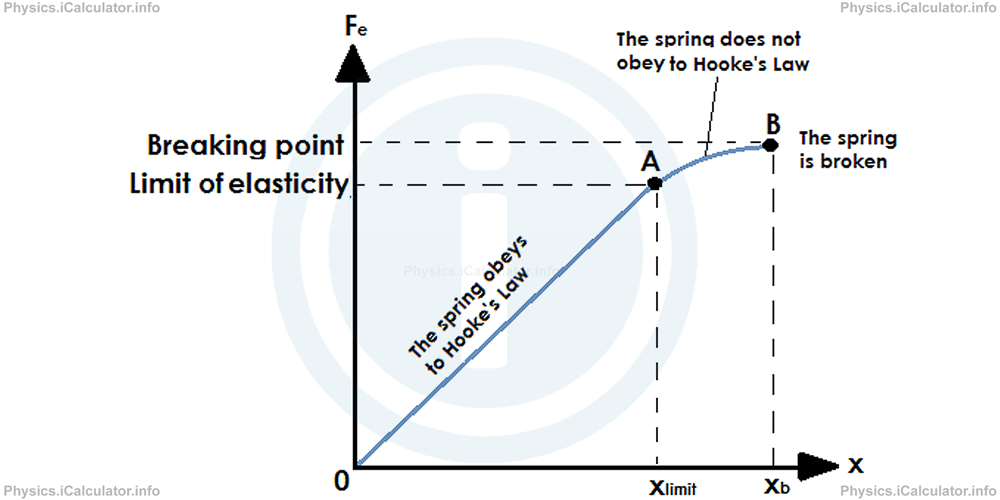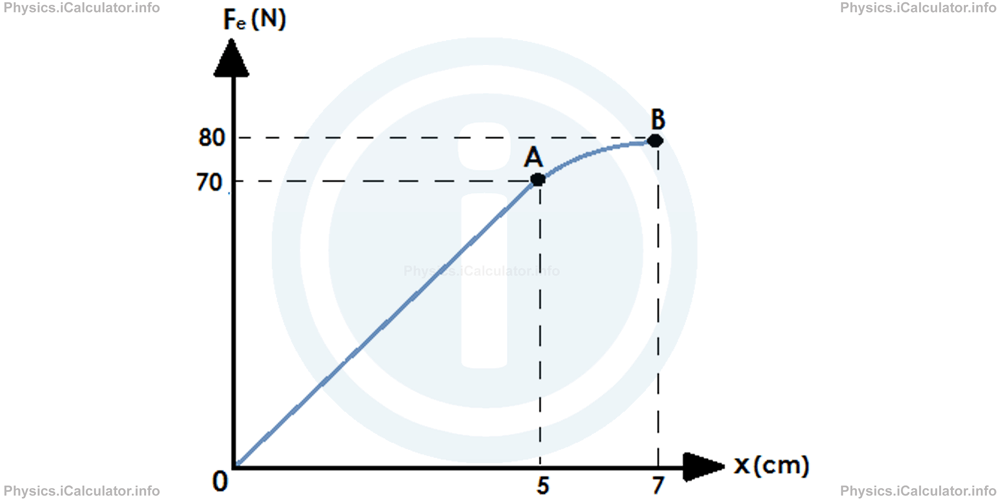Menu
Physics Lesson 4.4.3 - The Graphical Representation of Hooke's Law. Limit of Elasticity
Please provide a rating, it takes seconds and helps us to keep this resource free for all to use
Welcome to our Physics lesson on The Graphical Representation of Hooke's Law. Limit of Elasticity, this is the third lesson of our suite of physics lessons covering the topic of Types of Forces III (Elastic Force and Tension), you can find links to the other lessons within this tutorial and access additional physics learning resources below this lesson.
The Graphical Representation of Hooke's Law. Limit of Elasticity.
The equation (1) written in the scalar form, i.e. Fe = k × x shows a linear function whose graph is a slope that starts from the origin like the one shown in the figure below.

As long as the graph is linear, the elastic object involved (spring, rubber band etc.) shows a perfectly elastic behaviour. Therefore, the spring obeys the Hooke's law. However, when the pulling force is too large, the spring may not return to its original position. We say the force used has exceeded the limit of elasticity. For example, some dynamometers don't show anymore the value zero when they are not in use because heavy objects that exceed the limit of elasticity have been hanged on them.
When the object hanged is too heavy, the spring breaks into two pieces. The breaking point is represented through the letter B in the graph above.
Example 2
The elastic force vs deformation graph for a spring is shown in the figure below.

- What is the value of the spring constant in N/m?
- What is the minimum force to be used so that the spring does not turn again to its original position?
- What is the minimum force needed to break the spring in two pieces?
Solution 2
- The spring constant is calculated considering only the part OA of the graph as only in this part the Fe vs x graph is linear, i.e. it obeys the Hooke's Law.
Since the graph is linear, we can take two points on it and calculate the slope as discussed in the Kinematics chapter when we calculated the instantaneous velocity. For simplicity, we can take the origin O and the point A (at the origin the spring is unstretched). Thus, we have:
= 70N - 0N/5cm - 0cm
= 70N/5cm = 70N/0.05m
= 1400 N/m
- The minimum force to make the spring permanently loose its elastic properties is shown at the point A in the graph. The corresponding value of the elastic force in that point is 70 N. This value represents the elastic limit of the spring.
- The spring breaks at the point B as there is no more graph after this point. The corresponding value of the force is 80 N. This means when a 80 N force is used in the spring, it breaks in two pieces.
You have reached the end of Physics lesson 4.4.3 The Graphical Representation of Hooke's Law. Limit of Elasticity. There are 4 lessons in this physics tutorial covering Types of Forces III (Elastic Force and Tension), you can access all the lessons from this tutorial below.
More Types of Forces III (Elastic Force and Tension) Lessons and Learning Resources
Whats next?
Enjoy the "The Graphical Representation of Hooke's Law. Limit of Elasticity" physics lesson? People who liked the "Types of Forces III (Elastic Force and Tension) lesson found the following resources useful:
- Graph Feedback. Helps other - Leave a rating for this graph (see below)
- Dynamics Physics tutorial: Types of Forces III (Elastic Force and Tension). Read the Types of Forces III (Elastic Force and Tension) physics tutorial and build your physics knowledge of Dynamics
- Dynamics Revision Notes: Types of Forces III (Elastic Force and Tension). Print the notes so you can revise the key points covered in the physics tutorial for Types of Forces III (Elastic Force and Tension)
- Dynamics Practice Questions: Types of Forces III (Elastic Force and Tension). Test and improve your knowledge of Types of Forces III (Elastic Force and Tension) with example questins and answers
- Check your calculations for Dynamics questions with our excellent Dynamics calculators which contain full equations and calculations clearly displayed line by line. See the Dynamics Calculators by iCalculator™ below.
- Continuing learning dynamics - read our next physics tutorial: Newton's First Law of Motion. The Meaning of Inertia
Help others Learning Physics just like you
Please provide a rating, it takes seconds and helps us to keep this resource free for all to use
We hope you found this Physics lesson "Types of Forces III (Elastic Force and Tension)" useful. If you did it would be great if you could spare the time to rate this physics lesson (simply click on the number of stars that match your assessment of this physics learning aide) and/or share on social media, this helps us identify popular tutorials and calculators and expand our free learning resources to support our users around the world have free access to expand their knowledge of physics and other disciplines.